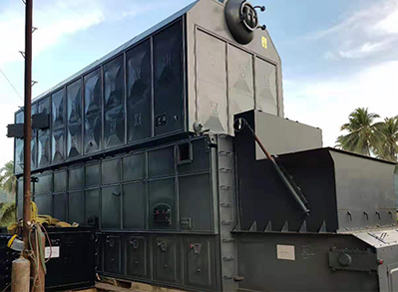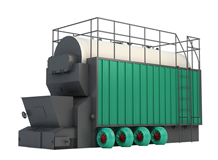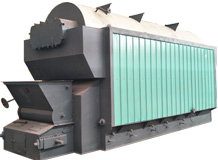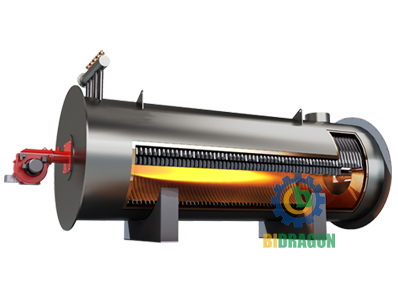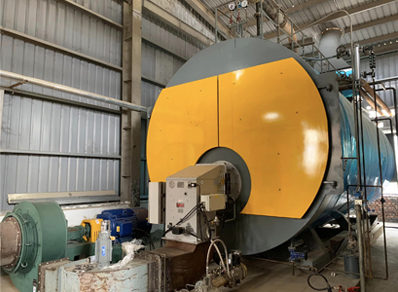
The Difference Between Steam Boiler and Hot Water Boilers
The Difference Between a Steam Boiler and a Hot Water Boiler
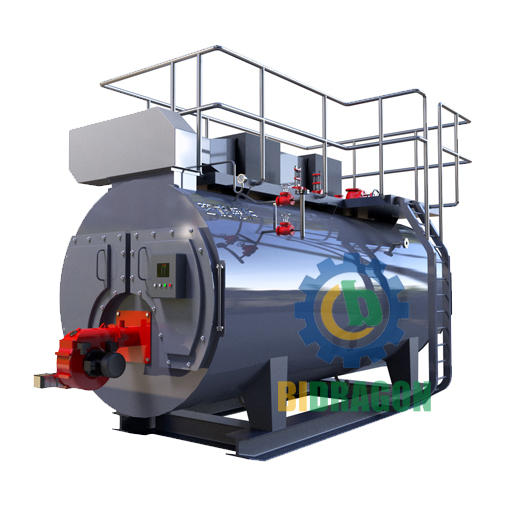
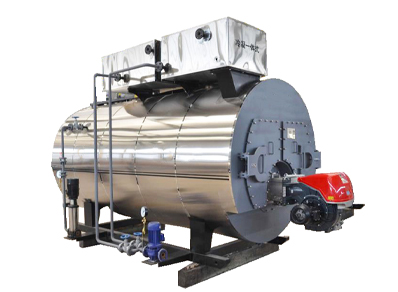
Boilers play a vital role in modern industrial production and everyday life. From powering factories to bringing warmth to homes, from food processing to generating electricity, boilers are everywhere. However, are you aware of what differences exist between steam boilers and hot water boilers? Next, let's dive into the differences between these two common boilers.
Differences in Heating Methods
Circulation Heating in Hot Water Boilers
Hot water boilers work by allowing water to flow in a closed circulation loop. Through the boiler body or a matching heat exchanger, the water is heated to the proper temperature for heating or other process needs. Throughout the process, the water remains in a liquid state, continuously circulating through the piping system, delivering a constant stream of heat to wherever it is needed.
Evaporative Heat Production in Steam Boilers
Steam boilers are quite different, as they convert water into steam by heating it to boiling. The resulting steam carries a large amount of thermal energy, which is transported to the equipment that uses the heat. Unlike the circulation pattern of hot water, steam is returned to the boiler as condensate after the heat is released, but the steam itself does not circulate through the system as hot water does.
Energy Efficiency Comparison
Hot Water Boilers: Stable and Efficient Heat Delivery
Hot water boilers offer excellent stability in terms of energy efficiency. Because the hot water flows in fixed pipes, it is able to be directed precisely to the area that needs to be heated, reducing the loss of heat during transmission. This precise distribution of heat enables hot water boilers to achieve efficient heating with low energy consumption when meeting localized or small space heating needs.
Steam Boilers: Advantages for Large Area Heating
Steam boilers show unique advantages in heat transfer once water is heated and converted to steam. Steam, as a gaseous substance, can quickly and efficiently transfer heat over long distances. In large buildings or industrial plants and other large-area heating scenarios, as well as in extremely cold regions, steam boilers are able to meet the heating needs of large spaces with less energy input, reflecting a high degree of energy efficiency.
High and Low Maintenance Requirements
Steam Boilers: Complex and Strict Maintenance Requirements
The maintenance of steam boilers is relatively complex. As it operates in a high-temperature and high-pressure environment, key parameters such as pressure, temperature and water level need to be strictly monitored on a regular basis to ensure the safe and stable operation of the equipment. At the same time, high temperature and high pressure can lead to rapid wear and tear of components such as pipes, valves and seals, which require frequent inspection and replacement. In addition, in order to ensure the safe operation of the steam boiler, the relevant safety equipment also requires regular maintenance and calibration, which usually requires the support of professional technicians.
Hot Water Boilers: Simple and Convenient Routine Maintenance
In contrast, maintenance of hot water boilers is much simpler. The main focus of attention is on the water circulation system, ensuring a smooth flow of water and the proper functioning of the circulation pump. For the combustion system, only routine cleaning and maintenance is required to ensure adequate fuel combustion. Due to the lower operating temperature of hot water boilers, there is less wear and tear on the internal equipment, which not only reduces the frequency of maintenance, but also simplifies the maintenance process, making hot water boilers an ideal choice for companies seeking easy maintenance and low-cost operation.
Differences in Installation Costs
Steam boilers: AComplex Installation With High Investment
The installation of a steam boiler is a complex process that requires a series of auxiliary facilities. For example, in order to transport high-temperature and high-pressure steam, special high-pressure piping must be installed, which needs to have good resistance to high temperatures, high pressures, and sealing performance. At the same time, it is also necessary to set up steam storage equipment to cope with fluctuations in the amount of steam used. In addition, the installation of a steam boiler needs to be equipped with a series of additional safety measures, such as safety valves and pressure gauges, in order to ensure safety. These factors result in higher initial installation costs for steam boilers, which are more suitable for large-scale industrial production or projects with special needs for high-temperature steam.
Hot Water Boilers: Easy Installation at Low Cost
Hot water boilers, on the other hand, are relatively simple to install. Because they do not have to deal with the transmission of high-pressure steam, their piping system and equipment requirements are relatively low. During installation, the main thing is to ensure that the hot water circulation piping is properly connected and that the relevant control equipment is installed. Hot water boilers do not require much installation space and supporting facilities, which makes their initial investment cost much lower, especially suitable for companies with limited budgets or projects with low demand for high-temperature steam.
Long-term Operation Cost a Nalysis
Steam Boiler: High Energy Consumption and High Maintenance Cost
Steam boilers are relatively costly in long-term operation. On the one hand, the high temperature and high pressure operating conditions make steam boilers consume a lot of energy, and fuel costs increase significantly, especially during continuous high load operation. On the other hand, complex maintenance requirements also lead to higher maintenance costs, frequent component replacement and the services of specialized technicians increase operating costs. As a result, the overall cost of a steam boiler is higher over the long term.
Hot Water Boilers: The Advantages of Energy Efficiency and Low Maintenance Costs
Hot water boilers offer significant cost advantages in long-term operation due to their efficient energy utilization and simple maintenance requirements. Lower operating temperatures result in less wear and tear on the equipment and relatively low energy consumption, reducing fuel costs for day-to-day operations. At the same time, simple maintenance reduces maintenance expenses, making hot water boilers more economical in long-term operation.
Key Considerations in Selection
Classification of Boilers
Pressure Classification and Application of Steam Boilers
Steam boilers can be classified into low-pressure steam boilers and high-pressure steam boilers according to their operating pressure. Low-pressure steam boilers typically operate at 15 PSIG (pounds of force per square inch gauge) and below, and are designed and manufactured in accordance with the American Society of Mechanical Engineers (ASME) Boiler and Pressure Vessel Code, Part IV. These boilers are commonly used in small industrial applications and building heating systems. High-pressure steam boilers, on the other hand, operate above 15 PSIG, are regulated by ASME Code Part I, and are used primarily in production processes that require large quantities of high-intensity steam output, such as manufacturing and power generation.
Hot Water Boiler Temperature Classifications and Uses
Hot water boilers are classified into two categories based on operating temperature. Hot water boilers with water temperatures of 250°F (degrees Fahrenheit) and below, which are also governed by Part IV of the ASME Code, and hot water boilers with water temperatures above 250°F, which are governed by Part I of the ASME Code. Hot water boilers are often used in heating scenarios that require more consistent temperatures and are not as extreme as steam systems, such as heating buildings and supplying domestic hot water.
Other Important Considerations
Fuel Source Selection
Boilers are available from a variety of fuel sources, including natural gas, propane, fuel oil, biofuels, and electricity. When selecting a fuel, a combination of fuel supply stability, cost, environmental emission requirements, and energy efficiency goals need to be considered. For example, natural gas is often the fuel of choice in many areas due to its clean combustion and relatively low cost, while electric boilers may be more advantageous in some locations where electricity is abundant and affordable.
Impact of Load Type
Load types can be categorized into steady and fluctuating loads. Steady loads are common in certain manufacturing processes where production is continuous, in which case the boiler can be sized to meet a steady heat demand. Fluctuating loads, on the other hand, such as the heating of large commercial buildings, are characterized by fluctuating heat demand over time and seasonal changes. For fluctuating loads, it is necessary to select a boiler that can flexibly adjust its output to avoid energy waste and excessive wear and tear on the equipment.
Regulatory Compliance
With increasingly stringent environmental requirements, modern boilers must meet strict emissions regulations, particularly limits on nitrogen oxides (NOx) and carbon dioxide (CO2) emissions. When selecting a boiler, it is important to ensure that the equipment selected meets the requirements of local environmental regulations, not only for the compliance of your business, but also to help minimize the negative impact on the environment.
Space Constraints
The amount of space in the facility is also an important factor in boiler selection. If space is limited, it may be necessary to choose a boiler with a compact design, or consider an option that combines several smaller boilers. Whereas, where space is more plentiful, a large single boiler may be selected to improve energy efficiency and reduce equipment costs.
Cost and Lead Time
In general, large, complex boiler systems not only have a higher initial cost, but also a longer lead time because of the more complex design, manufacturing and installation process. Relatively simple boiler systems are less expensive and can be delivered more quickly. During the planning stage of a project, the choice of boiler equipment needs to be rationalized, taking into account the budget and time requirements.
Maintenance and Usage Costs
In addition to the purchase cost, the long-term maintenance and usage costs of the boiler system need to be considered. This includes costs for the overall efficiency of the boiler, periodic inspections, component replacement, and emissions monitoring. When selecting a model, choose boilers that are easy to maintain and energy efficient to reduce long-term operating costs.
Installation Points
Steam Boiler Installation Considerations
Design for Ease of Maintenance
When installing a steam boiler, give due consideration to the ease of future maintenance. Ensure that all parts of the boiler can be easily inspected and repaired, for example, by installing manholes, handholes, and valves at different parts for regular maintenance and even replacing damaged pipes when necessary.
Equipment Size and Weight Considerations
The overall size and weight of the steam boiler and its ancillary equipment need to be accurately measured to ensure that it can be smoothly accessed in the plant room and installed in its designated location. This is especially important for large steam boilers to avoid installation difficulties or safety hazards due to size or weight issues.
Configuration of Water Treatment Equipment
Steam boilers require high water quality, so water hardness treatment equipment or sediment removers must be installed in the plant room to reduce water impurities and hardness. In addition, auxiliary equipment such as deaerators are required to pre-treat the boiler feed water to ensure that the water entering the boiler meets the water quality standards with a maximum allowable water hardness of 20 PPM (parts per million).
Auxiliary Equipment and Safety
When selecting and installing a steam boiler, in addition to focusing on the quality and performance of the boiler body, special attention should be paid to the selection and installation of auxiliary equipment. At the same time, it is important to ensure that the steam boiler has complete and effective safety devices, such as safety valves, pressure gauges, etc., to ensure the safe operation of the equipment.
Hot Water Boiler Installation Essentials
Water Quality Treatment Equipment Installation
Similar to steam boilers, hot water boilers require the installation of water hardness or sedimentation removal equipment, especially in plant rooms where steel hot water boilers are used. Good water quality treatment can extend the life of the boiler and improve the operating efficiency of the equipment.
Concrete Foundation Construction
Prior to installing a hot water boiler, a suitable concrete foundation should be made in advance, based on the size and location plan of the equipment. All major equipment in the plant room, including the central heating boiler, should be installed on a concrete foundation that meets the standards to ensure the stability and safety of the equipment.
Installation of Monitoring and Control Equipment
Each steel hot water boiler must be fitted with manometers and thermometers for real-time indication of the temperature of the hot water in the boiler and the pressure in the building heating system. In addition, an immersion thermostat with a temperature range of 30 to 90 degrees Celsius is required to regulate the boiler temperature and to control the starting and stopping of the burner.
Configuration of Safety Devices
In order to guarantee the safe operation of hot water boilers, each boiler must be fitted with at least one safety valve and one immersion thermostat. The safety valve is capable of automatically relieving pressure when it is too high, preventing the boiler from operating under overpressure. The thermostat precisely controls the heating process of the boiler according to the set temperature range, ensuring that the temperature of the hot water is stabilized within the safe range.
Differences in Application Areas
Wide Application of Steam Boilers
Power Generation
Steam boilers play a central role in power generation. In a power plant, high-temperature and high-pressure steam is generated by burning fuel, which drives a turbine to rotate at high speed and then a generator to generate electricity. A large steam turbine can generate enough energy to meet the electricity needs of an entire city, making it an efficient and reliable way to generate electricity.
Food & Beverage Industry
Steam boilers are used in a variety of critical processes in the food and beverage industry. It can sterilize production equipment to ensure a hygienic and safe production environment; pasteurize products to extend their shelf life; and steam cook to enhance the quality and taste of food products. Steam boilers provide an economical, efficient and hygienic heating method for food and beverage manufacturers.
Chemical Industry
Many chemical reaction processes in the chemical industry require the assistance of steam. Steam produced by steam boilers can be used to heat reacting materials, facilitate separation of substances, and clean and sanitize equipment. This versatility makes steam boilers an indispensable piece of equipment in chemical production.
Textile Industry
The textile industry is highly dependent on steam boilers. During the dyeing and drying process, steam provides the necessary heat and humidity conditions to ensure that textiles are uniform in color and texture. At the same time, the hot water produced by steam boilers can be used for textile cleaning and finishing, improving product quality and productivity.
Healthcare Industry
Steam boilers are widely used in hospitals and other healthcare facilities. Steam is used for cleaning and sterilizing medical equipment, ensuring a clean and safe medical environment. In addition, steam boilers provide space heating for hospitals, creating a comfortable medical environment.
Paper & Pulp Industry
Steam boilers are used to heat and dry wood fibers in the paper and pulp process, a critical step in the production of paper. At the same time, the steam produced by steam boilers is used for power generation and other industrial applications, providing the necessary energy support for the entire production process.
Common Application Scenarios for Hot Water Boilers
Centralized Heating for Buildings
Hot water boilers are widely used in centralized heating systems for residential, commercial and office buildings. Through radiators or fan coils, the heat carried by hot water is distributed indoors to create a warm and comfortable living and working environment for people.
Domestic Hot Water Supply
Hot water boilers are responsible for providing domestic hot water for households and public places to meet the needs of daily showering and washing. Its stable hot water supply capacity ensures the convenience and comfort of people's life.
Industrial Process Water Heating
Hot water boilers are used to heat process water in some industrial production processes that have specific requirements for water temperature. For example, some chemical production, food processing and other industries, need to accurately control the water temperature to ensure product quality, hot water boilers can meet these process needs.
Swimming Pool & Leisure Center Heating
In swimming pools and leisure centers, a hot water boiler is an ideal heating device. It effectively heats pool water to the right temperature to provide a comfortable swimming and leisure environment, and is widely used in both domestic pools and commercial leisure venues.
Greenhouse Heating
In order to maintain a stable temperature environment in greenhouses, hot water boilers are often used in greenhouse heating systems. By means of radiant floor heating or arranging piping along the walls, the heat from hot water is evenly distributed into the greenhouse to provide suitable temperature conditions for the growth of plants and to promote their healthy growth.
Conclusion
Steam boilers and hot water boilers differ significantly in terms of heating methods, energy efficiency, maintenance requirements, installation costs, long-term operating costs, selection considerations, installation points, and application areas. When choosing which boiler to use, you need to consider your actual needs, including the scale of heating, application scenarios, budget constraints, environmental requirements and other factors. Only a full understanding of the characteristics and differences between the two, in order to make the most suitable choice, to achieve efficient, economical and safe heat supply.

